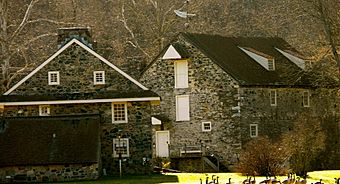Brinton's Mill facts for kids
Quick facts for kids |
|
|
Brinton's Mill
|
|

Brinton's Mill, December 2009
|
|
| Location | North of Chadds Ford on Creek Road, Birmingham Township, Pennsylvania |
|---|---|
| Area | 30.1 acres (12.2 ha) |
| Built | 1720, 1769, 1824 |
| NRHP reference No. | 71000689 |
| Added to NRHP | May 27, 1971 |
Brinton's Mill, also known as The Mill at Brinton's Bridge, is a very old and important building in Birmingham Township, Chester County, Pennsylvania. It's a type of mill called a grist mill, which was used to grind grain into flour. The first part of the mill was built around 1720. Later, it was made bigger in 1769 and updated again in 1824.
Around 1824, a granary was also built next to the mill. A granary is a special building used to store grain. There's also a stone house on the property. This house was built in the 1920s on the old foundation of an even older house from the early 1700s.
During the Battle of Brandywine in September 1777, an important event in the American Revolutionary War, General John Sullivan and his soldiers camped near the mill at Brinton's Ford.
In the early 1970s, the famous artist Andrew Wyeth owned the mill property. He and his wife, Betsy, bought and restored "The Mill" in 1958. These old 18th-century buildings appeared often in his paintings, like Night Sleeper (1979).
Brinton's Mill was added to the National Register of Historic Places in 1971. This means it's recognized as a special place in American history.
Contents
What is Brinton's Mill?
Brinton's Mill is a historic grist mill located in Chester County, Pennsylvania. A grist mill is a place where farmers would bring their grain, like wheat or corn, to be ground into flour or meal. This process was very important for making food in the past. The mill uses large grinding stones, often powered by water, to crush the grain.
How Old is Brinton's Mill?
The first part of Brinton's Mill was built around the year 1720. That makes it over 300 years old! Over time, the mill was expanded and improved. It was made larger in 1769 and then renovated in 1824. This shows how important the mill was to the local community for many years.
The Granary and Other Buildings
Around the same time the mill was updated in 1824, a granary was also built on the property. A granary is a building specifically designed to store grain safely. There is also a stone house on the property. This house was built in the 1920s, but it stands on the foundation of a much older house from the early 1700s.
Brinton's Mill and the American Revolution
Brinton's Mill played a small but interesting role during the American Revolutionary War. In September 1777, a major battle called the Battle of Brandywine took place nearby. During this battle, General John Sullivan and his American troops camped right next to the mill at a place called Brinton's Ford. This shows that the mill was located in an important area during the war.
Andrew Wyeth and the Mill
In more recent times, Brinton's Mill became famous because of its connection to the well-known American artist Andrew Wyeth. In 1958, Andrew Wyeth and his wife, Betsy, bought and restored the mill and its surrounding buildings. Wyeth loved the old buildings and the landscape around them.
The Mill in Wyeth's Art
The buildings at Brinton's Mill often appeared in Andrew Wyeth's paintings. He found inspiration in their history and appearance. One example of a painting that features the mill property is Night Sleeper, which he painted in 1979. His connection helped preserve the mill and brought it to the attention of many people.
Why is Brinton's Mill Important Today?
Brinton's Mill is important for several reasons. It's a great example of an early American grist mill and shows us how people lived and worked centuries ago. Its long history, including its role during the Revolutionary War, makes it a valuable historical site.
National Register of Historic Places
Because of its historical importance, Brinton's Mill was added to the National Register of Historic Places in 1971. This is a list of places in the United States that are considered worthy of preservation because of their historical significance. Being on this list helps protect the mill for future generations to learn from and enjoy.



